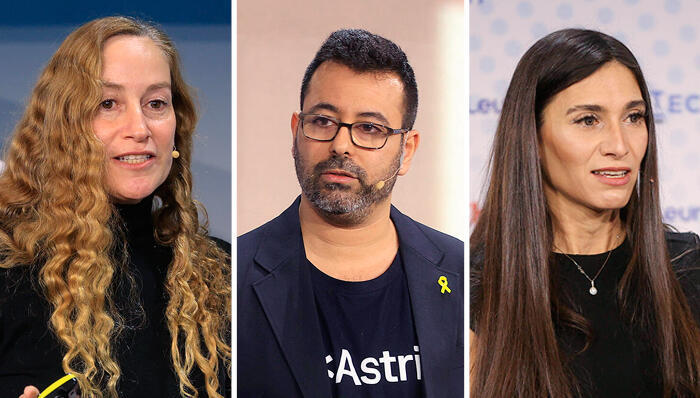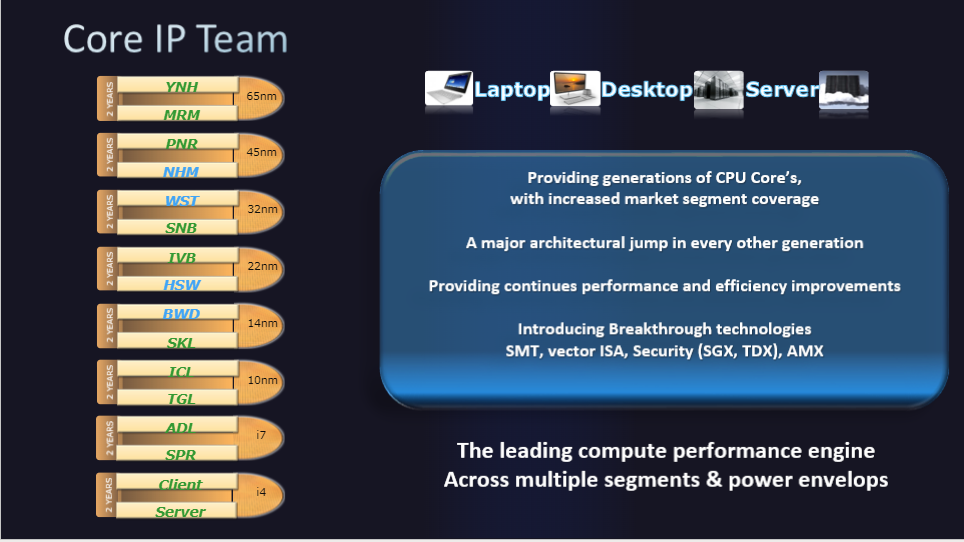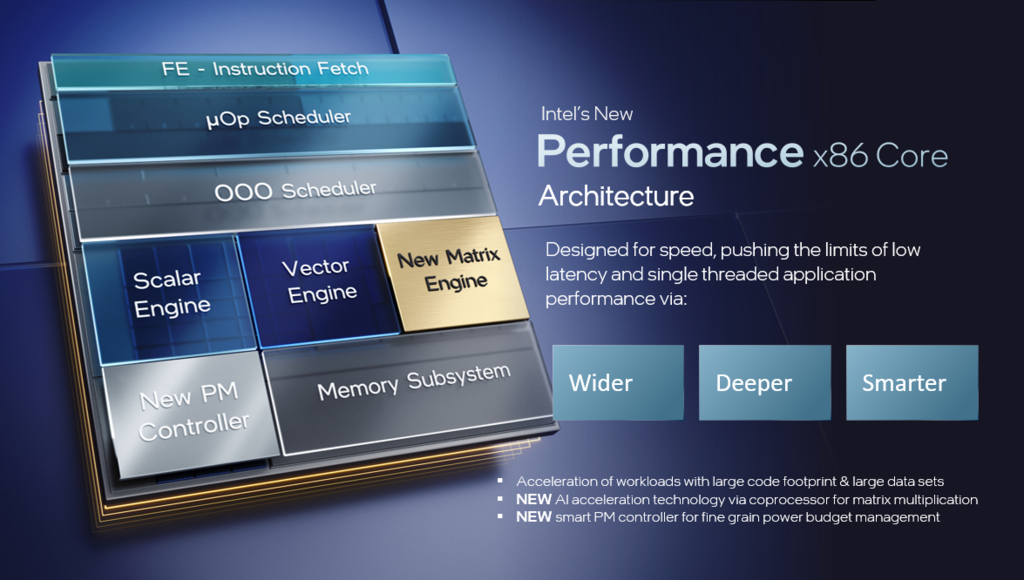
Like building the world's tallest tower every two years
Over the past decade, Intel Israel's Core Group has been responsible for the processors' most essential parts: the cores. What are they? How come they keep improving generation after generation? Get a rare view into how one of the most intricate and challenging technologies inside the processor are being developed.
"Today's Israel is a miniaturized version of Intel," Pat Gelsinger, CEO of Intel Corporation, said on his first visit to Israel in 2021. One reason for the central role that Intel Israel plays at Intel Corporation can be summed up in a single word with a big meaning – the core.
"In recent years, we have been embedding numerous functions into the System on the Chip (SoC).Until a decade ago, these functions formed part of the motherboard, such as the graphical processing and the control of the input and output, explains Jack Doweck, chief technology and security architect at Intel." But the core is the most critical part of the processor."
What is the core?
If you could shrink to a single nanometer and stroll through the Alder Lake processors that Intel recently launched, we would have felt we were walking in the streets of a modern city. The modem is on one side of the street, the graphical processor on the other, and the drives' socket wall is just behind them, as is the end of the channel connected to the external memory and other components. Everything is arranged nicely with convenient access: the roads in our microscopic chip city are the data channels that transfer the entire information that flows into and out of the chip at a speed of at leas5 5 Gigahertz.
The core is the central building of that city; the processor component that runs the computations required for each PC task, whether it involves counting the number of words in a Word document to the motion of wheels of the racecar in the video game you're playing, the processors is a calculator capable of performing a sequence of instructions which originate in the programming language used to write the operating system and the apps. They are translated into a binary language as a string of 0s and 1s. The core deciphers these strings, translating them into actions.
More and more cores
Not much has changed in the core's task list since Intel's first PC, the 4004 that recently marked its 50th anniversary. The cores continue to perform the instruction strings. For many years, each processor had only one core. However, in the 2000s, Intel developed dual-core processors (the Yonah and Merom projects). Since then, the number of cores has continued to grow with every year that went by. The small and lightweight laptops on the market today will have four cores, but servers' processors will have many dozens of them.
Having multiple cores in the computer allows running more than one program simultaneously and benefit from improved performance. For example, a contemporary PC with several cores can handle its workloads even when an antivirus scan is running in the background, data is backed to the cloud, and the user is watching a 4K video. These actions run in the background, while the PC alerts on new e-mails on Outlook and is running additional tasks.
But adding cores is no magic solution. Multiple cores make the processor bigger, more expensive, and hotter. The complexity does not end there. "Having multiple cores is like having many children. Everything is OK as long as each one minds their own business," explains Ido Ouziel, an architect with Intel's Core Group. "But as son two of them want to use the same resource, troubles start, as every parent with two adolescent girls and one bathroom would tell you."
One of the most complex machines developed in Israel
Power is a shared resource on which all cores compete. A core that performs highly complex computation will consume more power, which will leave less to the other cores, causing them to work slower.
In the new Alder Lake processor, Intel Israel's engineers created, for the first time, a hybrid computer with two types of cores: the Performance Core and the Efficiency Core. The Performance Cores are fit for heavier usage, whereas the Efficiency Cores for lighter applications.
The novel hybrid structures allow a better allocation of the programs running on the computer at a given time. As a result, one can run lighter programs on the efficiency cores, which consume less power and help maintain longer battery life. Alternately, more energy can be allocated to the performance cores to run the programs faster. Yet another use for the efficiency cores is with programs that run on several cores at the same time.
"The performance core is one of the most intricate machines we have ever developed. It is equivalent to building the world's tallest tower every two years when no one knows where to start. Then, two years later, you are required to build a tower 20% taller + a jacuzzi on the rooftop," explains Adi Yoaz, the chief architect of the performance core. "The know-how and the number of people involved in this project are huge – you need 1,000 people to build a core this complex."
The novelty of the new processors is not just the sheer number of cores but the way they manage themselves. "The commands are not necessarily performed in the order stipulated in the program. Instead, at any given moment, the core evaluates multiple commands in advance, reordering them in the most efficient order,' said Ouziel. He adds, "The new command ordering capabilities are more sophisticated, with each core performing 20% more operations per second compared with the cores of the previous generation."
Ouziel says better performance can sometimes be achieved with an enhanced manufacting process technology. At other times, the core needs to be modified using the same manufacturing process, which is more or less what happened in the current generation. "To make Alder Lake more efficient, we added control over the power consumption and current of each core individually, which the previous generation did not have. So when each core can run on a different frequency, the output can be managed more efficiently and better performance achieved without paying the price in energy."
In-processor AI
Only a few may know this, but Intel Israel's core development group is one of the few in the world that succeeds in innovating every year of all the development groups commissioned with developing processor cores. This group takes the credit for the dozens of cores that Intel launched over the recent decades, from the cores to the Banias, through Merom, the first dual-core processor for client PC and servers. They also gave Intel its reputation as a significant silicon development center to the modern cores for Sandy Bridge, Skylake, Tiger Lake, and Alder Lake. Over the years, Intel Israel's core group conceived unique technologies, the most recent one being Intel Advanced Matrix Extensions (AMX). AMX is an AI accelerating technology, and more specifically, the deep learning inside the core itself, with no need for an external component.
Low power consumption; high performance
In terms of development time, it takes about several years to build a system on a chip. As usually happens in product development, the first stage involves accepting the business requirements. The main requirement from the core is better performance without increasing the power consumption. How can this be achieved?
Since this is the first time an SoC contains different core types with different throughputs, the programs that run between the cores need to be balanced. The balancing work was commissioned to a mechanism called Intel® Thread Director. This new hardware addition provides the OS information on the running program, allowing it to pick the suitable core for the job.
"We combined precise calculations that the operating system does not know how to do on its own," says Doweck. "we count events of a specific type, then work out the which of the two core types is best suited to run each application , according to its nature."
Ouziel added, "Today's gamers, who are running very sophisticated computer games, are part of a massive industry that generates more revenue than Hollywood. Today's gamers want to run their heavy game while recording the action on screen, taking photos of themselves, merging the two clips, condensing the video, and sharing it with their friends, all at the same time. They want to achieve that without compromising the game performance or skipping a frame in the video. The core combination inside Alder Lake allows them to achieve it better than ever, all thanks to the cores born at intel Israel."

















